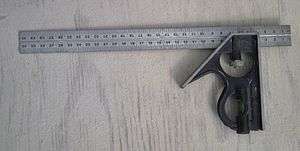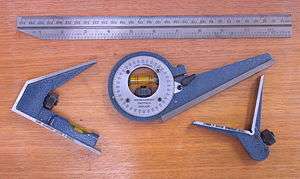Combination square


A combination square is a tool used for multiple purposes in woodworking, stonemasonry and metalworking. It is composed of a ruled blade and one or more interchangeable heads that may be affixed to it. The most common head is the standard or square head which is used to lay out or check right and 45° angles.[1] Invented in 1883 by Laroy S. Starrett,[2] the combination square continues to be a commonplace tool in home workshops, construction jobsites and metalworking.
Uses
- Measuring angles — A combination square can reliably measure 90° and 45° angles. The 45° angle is used commonly in creating miter joints.
- Determining flatness — When working with wood the first step is to designate a reference surface on a board which is known as the face side. The rest of the workpiece is measured from the face side
- Measuring the center of a circular bar or dowel. The rule is assembled through the center of the center square, the two cast iron legs of the center square are then placed against the outside of the bar (dowel) allowing a center line to be scribed alongside the ruler. Perform this action at two locations and the intersecting lines will approximate the center of the bar (dowel).
- Protractor head allows angles to be set and measured between the base and ruler.
- A rudimentary level for approximating level surfaces is incorporated in the protractor and also the 45° holder.
- By moving and setting the head, it can be used as a depth gauge or to transfer dimensions.
- Marking the work surface; with the included Scribe Point stored in a drilled hole in the Square Base.
- It is used to find the center of the round jobs.
In woodworking, the starting raw material is neither flat nor square, however, the end product such as a table must be flat and have corners and legs which are square.
In metalworking, it is useful for a wide variety of layout and setup tasks. When used correctly, a fairly high degree of precision can be achieved. One use would be setting large items at the required angle in machine vices, where the long reach of the ruler and firm, heavy base aid the process.
References
- ↑ Campbell, Paul D. Q. (1995). An introduction to measuration and calibration. Industrial Press Inc. ISBN 978-0-8311-3060-2.
- ↑ "Beveling Instrument". USPTO. US Patent and Trademark Office. Retrieved 6 August 2015.